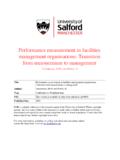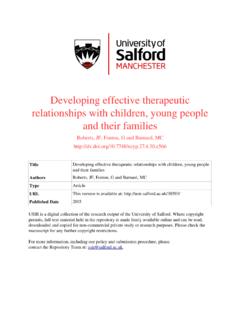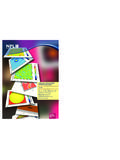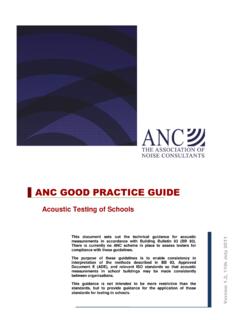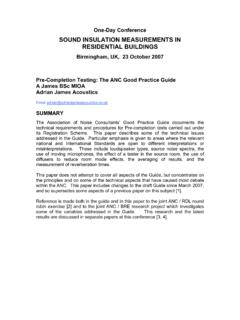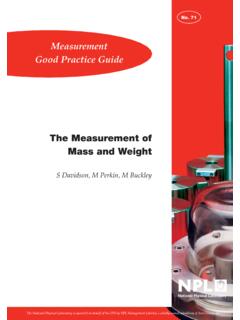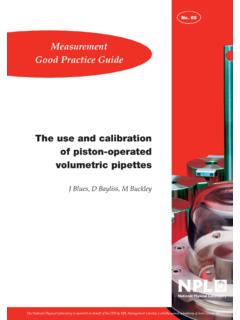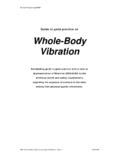Transcription of A Good Practice Guide on the Sources and …
1 DTI Project: - National measurement System Programme for Acoustical Metrology A good Practice Guide on the Sources and magnitude of uncertainty Arising in the Practical measurement of Environmental Noise N J Craven, G Kerry School of Computing, Science & Engineering The University of Salford Salford M5 4WT Edition 1a May 2007 Uncertainties in Noise measurement Uncertainties in Noise measurement Acknowledgements The University of Salford wishes to acknowledge the financial support provided by the National measurement System Programme for Acoustical Metrology, Department of Trade and Industry for this project, and the practical support provided by Stanger Science & Environmental, Ian Campbell Associates, and Andrew Dutton. The authors particularly wish to thank the above and all their colleagues, and members of the Institute of Acoustics and local authorities who provided valuable comments.
2 Published by the University of Salford School of Computing, Science & Engineering Salford M5 4WT ISBN: 0-9541649-0-3 Version 1a, May 2007 Version 1a, May 2007 University of Salford University of Salford Uncertainties in Noise measurement Uncertainties in Noise measurement CONTENTS Chapter Title Page 2 measurement 3 FORMULATION OF uncertainty List Sources on Uncertainties and Estimate Standardise to Same Confidence to Same Combined Re-scale to Expanded Budget BUDGET BUDGET 4
3 measurement EXERCISE AND OTHER EXAMPLES AND uncertainty of Traffic Noise from a Fabrication /continued over Version 1a, May 2007 Version 1a, May 2007 University of Salford University of Salford Uncertainties in Noise measurement Uncertainties in Noise measurement Version 1a, May 2007 Version 1a, May 2007 University of Salford University of Salford 37 N Source Instrum T Chapter Title Page 5 AREAS OF uncertainty .
4 OISE 37 Spectral Content (Broadband and Tonal Noise) .. 38 Point, Line and Area Sources /the Near and Far 40 State of Repair and 42 Height ..42 Movement of the Noise 42 , Buildings and 43 43 RANSMISSION 44 45 Ground Effects .. 50 54 56 e entation .. 61 Choice of measurement 84 Noise Level .. 85 Attended and Unattended Noise Monitoring .. 88 Permanent Noise 89 EY 89 he 89 he 90 he 90 he Source Owner .. 90 APPENDICES Appendix 1 Legislation, Standards, Procedures and Guidelines ..93 Appendix 2 Case Studies .. 99 Appendix 3 uncertainty Budget Spreadsheet for Environmental Noise Measurements ..103 Uncertainties in Noise measurement Uncertainties in Noise measurement _____ 1 INTRODUCTION Advances in technology have helped reduce instrumentation measurement errors and uncertainties, especially in the functioning and calibration of sound level meters.
5 However, the way in which sound level meters are used and the conditions under which they are operated, especially when out of doors, can give rise to additional uncertainties that can considerably influence the interpretation of any results obtained. Indeed the whole measurement chain must be considered as a source of uncertainty in a final measured value. Changes in the way in which the source of noise is operated or controlled, changes in parameters such as weather conditions or ground surface conditions over the propagation path, or changes in the conditions at the receiver where the sound level meter is placed, are typical examples of potential Sources of uncertainties. Identifying all the Sources and magnitudes of such uncertainties provides a means, not only of quantifying the total uncertainty in any environmental noise measurement , but also a route to minimising or at least reducing some of them, with a resultant beneficial improvement in the accuracy of the final result.
6 All measurement results have an associated element of doubt about their true value. In general terms, this is known as measurement uncertainty , and is attributed in part to unknown factors influencing the measurement , or an inability to determine the influence of a known quantity with a better accuracy. In the case of environmental noise measurements, it is usually factors influencing the source and propagation path rather than instrumentation shortfalls that influence measurement uncertainty . A knowledge of the source and magnitude of these factors will assist with interpretation of the results, indicating differences which may not be significant and identifying areas where greater attention to detail can improve assessments. The aim of this Guide is to present uncertainties in as simple a manner as possible, so that users will take up the ideas and use the information to either define the magnitudes of the final measurement uncertainty , or identify the probable Sources of uncertainty .
7 Some practitioners find the determination of uncertainties daunting. In this Guide , a simple and straight-forward approach has been adopted which will allow the user to decide what is required and how much can be done, based on the available information. As a basis for handling uncertainties, the straightforward approach adopted by Stephanie Bell1 has been adopted. This type of approach has proved successful in situations where there is a reasonable degree of control on the Version 1a, May 2007 Version 1a, May 2007 Page 1 University of Salford University of Salford Page 1 1 BELL, STEPHANIE, A Beginner s Guide to uncertainty of measurement , measurement good Practice Guide No 11, 1999, NPL Uncertainties in Noise measurement Uncertainties in Noise measurement measurement parameters.
8 However, there is no reason why it cannot be applied to the measurement of environmental noise where there is little control on some extraneous factors. The content of the good Practice Guide is based on assessments, inter-comparison exercises, and case studies that have been carried out or obtained and analysed in terms of uncertainties arising from relevant environmental effects, measurement Practice and instrumentation uncertainties. A key element of the Guide has been to provide the necessary procedural material for evaluating uncertainties in an easily digestible form suitable for all practitioners. The approach taken is to break each environmental noise measurement exercise into three stages, which can be described as the source, the transmission path and the receiver, and to consider the processes and associated uncertainties in each stage.
9 An uncertainty budget is then drawn up for each stage, and used to evaluate the final combined uncertainty . In a real environmental noise measurement situation it can be extremely difficult to provide a reliable estimate of uncertainty , because it is unique to the particular circumstances of the application. However, by using information and guidance obtained from relevant Sources and references, and from carrying out practical studies, it should be possible to evaluate the source of most uncertainties in a measurement , and make an estimate of the magnitude . A list of useful references is included, so that the user can take the analysis further if deemed necessary. Standards on environmental noise measurement will, in future, require an assessment of the measurement uncertainty to be made. This Guide offers an appropriate means of determining such uncertainties.
10 The emphasis of the Guide is on the adoption of good Practice to reduce uncertainties in measurement results. Identifying Sources and magnitudes of uncertainty are essential to identify where measurement Practice can best be improved. A knowledge of the magnitude of the uncertainty in a measurement is particularly useful when comparing measurements with guidelines or with another measurement result. Version 1a, May 2007 Version 1a, May 2007 Page 2 University of Salford University of Salford Page 2 Uncertainties in Noise measurement Uncertainties in Noise measurement Version 1a, May 2007 Version 1a.
